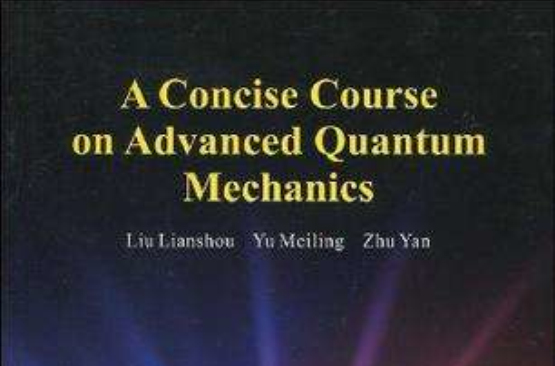《高等量子力學簡明教程》是2009年科學出版社出版的圖書。
基本介紹
- 書名:高等量子力學簡明教程
- 頁數:259頁
- 裝幀:平裝
- 開本:16
圖書信息,內容簡介,圖書目錄,
圖書信息
出版社: 科學出版社; 第1版 (2009年9月1日)
外文書名: A Concise Course on Advanced Quantum Mechanics
叢書名: 21世紀高等學校物理學精品教材
正文語種: 英語
ISBN: 9787030253187
條形碼: 9787030253187
尺寸: 23.8 x 16.8 x 1.2 cm
重量: 399 g
內容簡介
《高等量子力學簡明教程(英文版)》內容簡介:This book covers the main topics of modern advanced quantum mechanics in a concise way. It meets the requirement of the graduate students who plan to specialize in various fields of physics, e.g. theoretical physics, high energy physics, nuclear physics, condensed matter physics, atomic and molecular physics, optics, astrophysics and etc. It is for use in a one-semester graduate course. The main concepts, theorems and applications of quantum mechanics are written in the text, while most of the derivations are put in the exercises. Hints are given for selected exercises.
圖書目錄
Preface
Chapter 1 Quantum states and physical quantities
1.1 Quantum states as linear vectors in Hilbert space
1.1.1 Quantum states as linear vectors
1.1.2 Axiom of quantum mechanics concerning quantum states
1.2 Physical quantities as operators in Hilbert space
1.2.1 Eigenvalue and eigenvector of Hermitian operator
1.2.2 Orthogonal-normalization condition of eigenvectors
1.2.3 Axiom of quantum mechanics concerning physical quantities
1.2.4 Completeness condition of eigenvector system
1.2.5 Projection operator
1.2.6 Density operator Pure state and mixed state
1.3 Representation
1.3.1 Definition of representation
1.3.2 Representation transformation
1.3.3 Enter in and escape from a representation
1.3.4 Invariances of representation transformation
1.4 Operators as non-commuting quantities
1.4.1 Simultaneous measurability of physical quantities
1.4.2 Commutator algebra
1.4.3 Function of operator
1.5 Unitary transformation Generator of continuous transformation
1.5.1 Similar transformation and unitary transformation
1.5.2 Relation between unitary operator and Hermitian operator
1.5.3 Continuous transformation Generator
1.5.4 Space displacement Momentum
1.5.5 Space rotation Angular momentum
Chapter 2 Time evolution of microscopic system SchrSdinger equation and propagator
2.1 Time evolution in coordinate representation
2.2 Time evolution operator in Hilbert space
2.3 Picture in quantum mechanics
2.3.1 Definition of picture and picture-transform in quantum mechanics
2.3.2 SchrSdinger picture and Heisenberg picture
2.3.3 Interaction picture
2.4 Time evolution in the form of path integral
2.4.1 Functional integral formula for propagator
2.4.2 Functional integral as limit of multiple-integral
2.4.3 Functional integral as sum over path
2.4.4 Path-integral of Gaussian type
2.4.5 From path integral to SchrSdinger equation
2.5 Diffraction phenomena in quantum mechanics
2.5.1 The role of phase in quantum mechanics
2.5.2 Double-slot diffraction
2.5.3 Aharonov-Bohm effect Magnetic-flux quantum
2.6 Symmetry of microscopic system and conservation of physical quantity
2.6.1 Symmetry of microscopic system
2.6.2 Conservation of physical quantity
2.6.3 Parity
2.6.4 Time reversal
Chapter 3 Angular momentum
3.1 General solution of the eigenvalue problem of angular momentum
3.1.1 The procedure for solving eigenvalue problem directly in Hilbert space
3.1.2 Solution of the eigenvalue problem of angular momentum
3.2 Two kinds of angular momentum
3.2.1 Orbital angular momentum
3.2.2 Spin
3.3 Spin 1/2
3.3.1 Properties of Pauli matrix
3.3.2 Density matrix of spin 1/2 state Polarization vector
3.4 Representation of angular momentum
3.4.1 Reducible and irreducible representations
3.4.2 Irreducible tensor operator
3.4.3 Property of D function
3.5 Addition of angular momentum Clebsch-Gordan coefficients
3.5.1 Addition of angular momentum
3.5,2 Clebsch-Gordan coefficients
3.5.3 Addition of D function
Chapter 4 Multi-particle system
4.1 Axiom on indistinguishability of identical particles
4.2 Fock representation of multi-particle state —— Discrete spectrum
4.2.1 The representation basis
4.2.2 Basic operators
4.2.3 Action of basic operators on representation basis
4.2.4 Representation- and canonical-transformations of annihilation and creation operators
4.2.5 Operators of physical quantities in multi-particle system
4.3 Fock representation for continuous spectrum
4.3.1 Second quantization
4.4 Time evolution in Fock representation
4.5 Theory of superconductivity
4.5.1 The BCS theory of superconductivity
4.6 Two-state system
4.6.1 Two-electron system
4.6.2 Quantum bit Bell inequality
Chapter 5 Uncertainty relation Coherent state
5.1 Uncertainty relation Minimum-uncertainty state
5.1.1 Uncertainty relation
5.1.2 Minimum-uncertainty state
5.1.3 Schwartz inequality
5.2 Harmonic oscillator
5.2.1 Solution of eigenvalue problem
5.2.2 Time evolution of harmonic oscillator in Heisenberg picture
5.3 Coherent state
5.3.1 Definition of coherent state
5.3.2 Properties of coherent state
5.3.3 Representation with coherent states as basis
5.3.4 Production of coherent state
5.3.5 Coherent state in coordinate representation
5.3.6 Displacement, rotation and squeeze operators for coherent states .
Chapter 6 One-dimensional problem Bound states and resonances
6.1 Three-dimensional scattering and one-dimensional transmission and reflection
6.2 Piecewise constant potential
6.2.1 Potential box
6.2.2 Rectangular potential well
6.3 Poles of scattering amplitude in the complex E plane
6.3.1 Scattering resonance
6.3.2 Poles of scattering amplitude on negative E axis Discrete energy levels
6.3.3 Poles of scattering amplitude in complex E plane Breit-Wigner formula
6.4 Space-time evolution of one-dimensional scattering
6..4.1 Wave packet
6.4.2 One-dimensional wave packet scattering
6.4.3 Energy-time uncertainty relation
6.5 Slowly-varying potential Semi-classical (WKB) approximation
6.5.1 Canonical and' path-integral quantizations
6.5.2 The semi-classical approximation (WKB approximation)
6.5.3 Application of semi-classical approximation
6.6 The connection formulae for WKB approximation
Chapter 7 Three-dimensional Scattering
7.1 Asymptotic form of scattering Differential cross section
7.2 Formal theory of scattering
7.2.1 Lippmann-Schwinger Equation
7.2.2 An alternative derivation of L-S equation
7.2.3 L-S equation in coordinate representation
7.2.4 Properties of scattering state
7.2.5 Scattering matrix
7.3 Partial wave phase shift
7.3.1 Wave function of free particle in spherical coordinate
7.3.2 Spherical Hankel and spherical Neumann functions
7.3.3 Partial wave expansion of scattering amplitude
7.3.4 Three dimensional square well
7.4 Elastic and inelastic scattering
7.4.1 Pure elastic scattering
7.4.2 Elastic scattering in the presence of inelastic processes
7.4.3 Optical theorem
7.5 Approximation methods for high energy scattering
7.5.1 Born approximation
7.5.2 Eikonal approximation
7.6 Wigner-Eckart theorem
Chapter 8 Relativistic quantum mechanics
8.1 Klein-Gordan equation and the difficulty of negative probability
8.2 Dirac equation
8.3 The spin of Dirac particle
8.4 Free particle solution of Dirac equation
8.5 Dirac equation in electro-magnetic field Magnetic moment of electron
Hints to Selected Exercises
H.1 Quantum states and physical quantities
H.2 Time evolution of microscopic system
H.3 Angular momentum
H.4 Multi-particle system
H.5 Uncertainty relation Coherent state
H.6 One-dimensional problem Bound States and resonances
H.7 Three-dimensional Scattering
H.8 Relativistic quantum mechanics
Index

